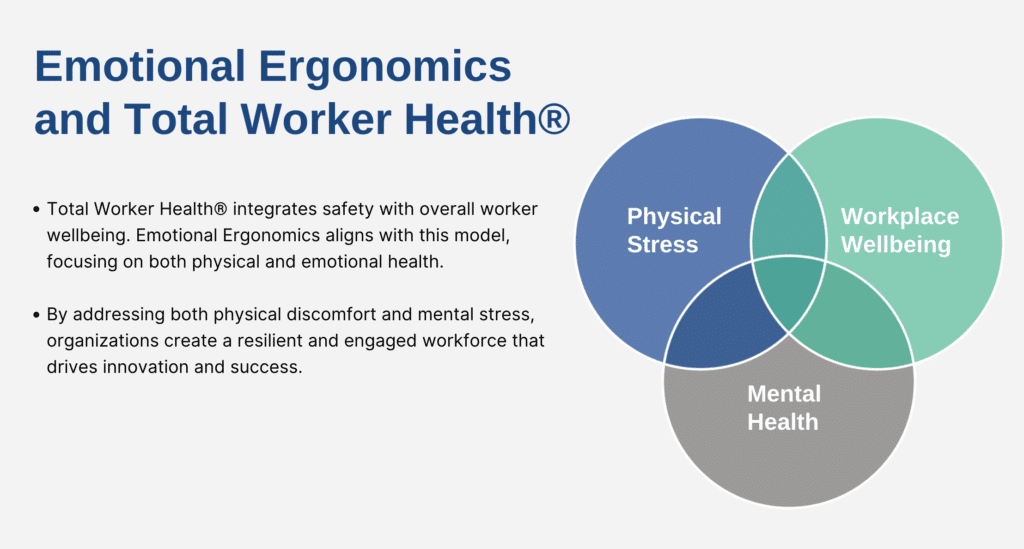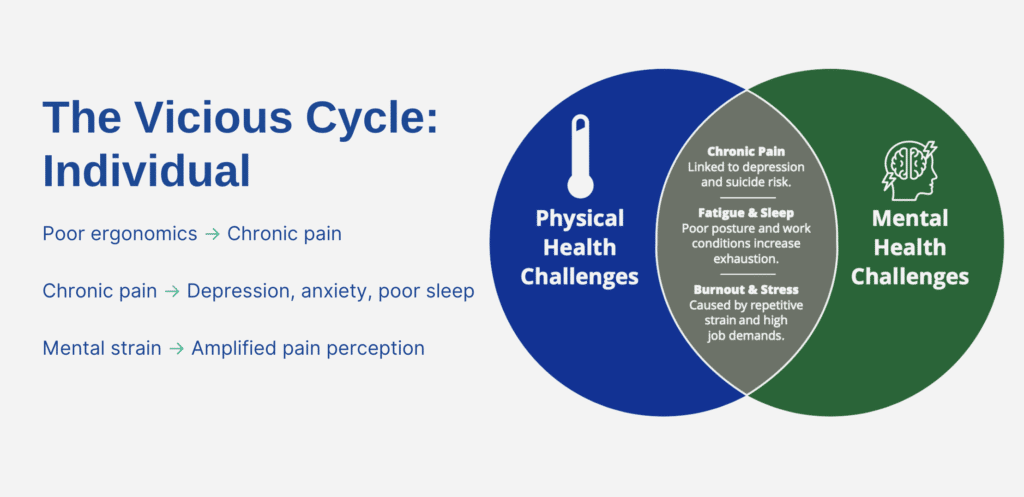Understanding and implementing Emotional Ergonomics can transform workplace dynamics, leading to improved safety and productivity. Today’s workplaces are fast-paced, highly dynamic, and demanding physically, mentally, and emotionally. Across industries, employees are experiencing pressure like never before. As expectations rise and support systems fall short, organizations face a crucial challenge: how to keep workers safe, healthy, and engaged in a world that feels increasingly volatile.
While traditional ergonomics focuses on optimizing the physical work environment, these approaches alone are no longer sufficient. Piecemeal interventions targeting isolated risk factors can’t keep up with the complexity of modern work. What’s needed now is a shift to a broader, more human-centered approach to worker health and safety.
Emotional Ergonomics: The Missing Link in Injury Prevention
Emotional Ergonomics is an emerging paradigm that addresses the deep interconnection between physical health, mental well-being, and the emotional experience of work. It offers a comprehensive roadmap for designing systems, environments, and cultures where employees can not only perform at a high level but thrive.
By integrating principles from behavioral science, biomechanics, user experience, and traditional ergonomics, Emotional Ergonomics seeks to minimize emotional friction in the workplace and promote psychological flow. The goal is to support not just physical safety, but also emotional resilience, cognitive clarity, and social belonging.
This forward-thinking approach aligns with the Total Worker HealthⓇ model developed by NIOSH, which advocates for integrated solutions that address both occupational safety and worker well-being.

What is Emotional Ergonomics?
At its core, Emotional Ergonomics refers to the intentional design of systems, tools, environments, and policies that enhance:
- Physical comfort and efficiency
- Emotional well-being
- Psychological safety
- Cognitive satisfaction
It builds upon the foundations of traditional ergonomics, fitting the task to the worker, but expands the lens to include the broader emotional and mental experience of employees, both on and off the job.
Just as physical injuries can lead to mental health challenges, the reverse is also true. Chronic pain, anxiety, depression, and burnout often go hand-in-hand, forming a self-reinforcing cycle that drives down productivity and drives up costs.

By applying the NIOSH hierarchy of controls to psychosocial hazards, Emotional Ergonomics introduces a systemic way to reduce or eliminate the mental health risks caused by:
- Uncertainty and volatility
- Poor work design
- Toxic organizational cultures
- Chronic emotional strain
Why It Matters: Emotional Load Is the Hidden Cost of Workplace Design
Consider these statistics:
- 70-80% of American workers report experiencing work-related stress
- 52% of all reported workplace injuries are mental health–related
- Workplace stress contributes to $190 billion in U.S. healthcare costs annually
Add to that the fact that more than 30% of workers’ compensation claims are due to ergonomic injuries, and nearly 1 in 5 workers suffer from chronic pain, and a clear pattern emerges: mental and physical health are inextricably linked.
Cognitive performance can drop by up to 35% in individuals experiencing severe depression, while physical task efficiency may fall by 20%. These declines affect not only employee well-being but also safety outcomes, productivity, and operational success.
Many of these risks don’t stem from physical tasks alone. They’re rooted in broader workplace factors:
- Excessive workloads and unrealistic deadlines
- Poor communication and a lack of leadership support
- Toxic or discriminatory cultures
- Harassment, bullying, or psychological hazards
- Unclear roles, low autonomy, and poor job security
This cumulative strain is what we call emotional load, the unseen weight of managing emotions in an environment that doesn’t support emotional processing. Emotional load drains cognitive and emotional resources, leaving workers exhausted, disengaged, or unsafe.
Breaking the Cycle: Practical Applications of Emotional Ergonomics
To change outcomes, we must change the system, not the individual.
Imagine a wilting plant. You don’t blame the plant; you check the light, the soil, and the water. Similarly, Emotional Ergonomics encourages us to assess and optimize the environment of work, not just the worker.
Here are actionable ways organizations can implement Emotional Ergonomics:
Engineering Controls
- Design adjustable workstations that promote posture, reduce muscle tension, and improve cardiovascular health.
- Optimize lighting and reduce noise to create calmer, more focused environments.
Administrative Controls
- Implement shift rotation to reduce fatigue and prevent burnout.
- Promote flexible schedules to support work-life balance.
- Review policies for clarity, equity, and accountability.
- Eliminate tolerance for aggression or abuse in workplace culture.
Behavioral Controls
- Provide access to on-site or subsidized fitness facilities.
- Educate employees about nutrition, hydration, and energy regulation.
- Offer evidence-based pain management tools and self-care training.
- Integrate mental health support through counseling, mindfulness programs, and app-based wellness resources.
- Create social spaces to promote belonging and connection.

What’s Next: Building the Future of Work
This blog kicks off a three-part series exploring Emotional Ergonomics in depth. In upcoming installments, we’ll share a roadmap for implementation and case studies from organizations that are redefining what safety and well-being mean at work.
For EHS leaders, HR executives, and safety professionals, Emotional Ergonomics offers an opportunity to lead real change, not only reducing injuries and claims but also building workplaces that attract and retain top talent.
Download the Emotional Ergonomics White Paper. Learn how holistic ergonomics can transform your workplace from the inside out.
Watch the Emotional Ergonomics Webinar. Explore the science, strategy, and success stories behind this groundbreaking approach.
Want to integrate Emotional Ergonomics into your workplace? Contact DORN Companies today to explore customized ergonomic and injury prevention programs designed to support your people, body, mind, and soul.


